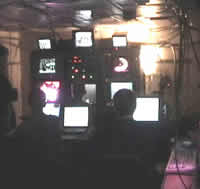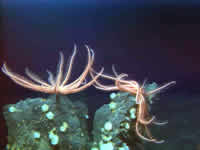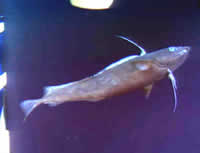| |
Teacher Logbook - NOAA Ship Ron Brown
 Jeff
Goodrich's Sealog: Jeff
Goodrich's Sealog:
South Cleft Segment of Juan de Fuca Ridge
I'm sitting
in the darkened ROPOS control room (image left) where the only illumination
comes from the 22 computers and monitors scattered throughout the crowded
space. Air conditioner vents continually blow out cold air to keep the
computers cool. This requires everyone inside to wear polar fleece. Geologist
Bill Chadwick directs the ROPOS pilots in his attempt to connect, via
an infrared reader (IR), and collect data from the eleven extensometers
spaced across the axis of the spreading center some 2200 meters below
the ship. This is no easy task as the IR sensors on the extensometer and
on ROPOS's IR port must be lined up perfectly. Bill must also obtain pressure
measurements from each extensometer location. Any movement during data
collection terminates the readings so weather becomes an important issue.
Ship movement due to high seas tugs at the cage which, in turn, tugs at
ROPOS and the instruments it carries. Tension is high during the long,
monotonous 20 minute pressure readings. Occasionally they must start over.
Bill is patient, persistent, and successful. Periodically crowds of scientists
gather in the room to witness the process.
| |

On our way to benchmark 9, the ROV came
upon these two beautiful brisingid sea stars - arms outstretched while
filter feeding. Other unidentified invertebrates (white shapes) share
the lava rock perch.

While performing infrared and pressure
readings at benchmark 9 (2215 meters), an unidentified fish measuring
over one meter in length came to check out what we were doing. The
fish has eye sockets, but no eyes, because at this depth everything
is dark (except when ROPOS comes to visit). |
|
The ROPOS
control room is divided into stations where numerous people communicate
in order to make a dive successful. In front of a Star Trek-like control
console sit two ROPOS pilots that fly the vehicle with a joystick, use
its two hydraulic arms to take samples and operate any other equipment
placed on the vehicle for a particular dive. Navigation is important,
as the pilots often cannot see more than several feet in front of them.
So, a navigator uses a network of transponders and transducers to relay
the location of the ship, the cage, ROPOS and any features to the pilots
for successful flying. Periodically the navigator calls the ship's bridge
and requests that the ship move to a different position.
Sitting adjacent
to the pilots are the scientists. They tell the pilots where to go, what
to sample and will often talk into a microphone so that the whole room
can hear what's going on. ROPOS allows for many different scientists to
see the ocean floor at the same time. This is advantageous as chemists,
biologists, geologists and engineers can bounce ideas off each other and
makes this type of ocean floor exploration truly interdisciplinary.
A logger
sits at a computer behind the ROPOS control console and records everything
that goes on during a dive. A log is compiled at the end of the dive so
that scientists can refer back to the dive months later and find out what
happened at specific times. Sitting behind the logger is a video logger
that records the entire dive on a series of SVHS, beta and digital video
recorders. Periodically, when interesting creatures or geologic features
come across one of ROPOS's two video cameras, a frame grab is taken. All
of the frame grabs go into the dive log and some of these still pictures
appear on this web page for your viewing pleasure.
After completing
the data transfer, the last of the extensometers is placed and calibrated.
The extensometer array will record data for another year. Our next task
is to retrieve HOBO's (high temperature recorders) from the two nearby
vents, Plume and Vent 1. Stay tuned for our first look at some black smokers.
|
|

